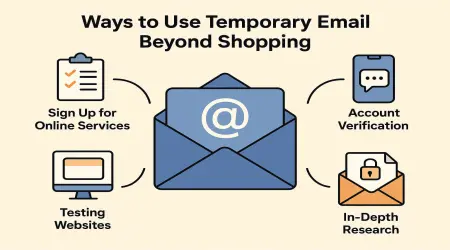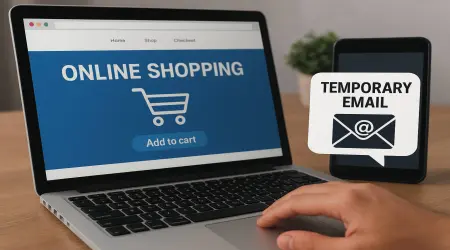

10 Smart Ways to Use Temporary Email Beyond Shopping
When you hear “temporary email,” what’s the first thing that comes to mind? For most, it’s a quick trick for getting a discount code when shopping online without signing up for a lifetime of promotional spam. While that’s a great use, it’s like using a state-of-the-art smartphone only to make calls—you’re missing out on its most powerful features.
A temporary email (also known as a disposable or anonymous email) is one of the most versatile tools for privacy protection in your digital toolkit. In a world where your personal data is a valuable commodity, a disposable email acts as a shield, allowing you to interact with the digital world on your own terms. It’s your key to unlocking content, testing services, and protecting your identity far beyond the checkout page.
This guide will explore ten intelligent ways you can leverage temporary email in 2025 to enhance your online security, avoid spam, and reclaim control over your digital footprint.
1. Signing Up for Free Trials Without the Spam Aftermath
The Scenario: A new productivity app or streaming service promises to revolutionize your life. They offer a 14-day free trial, and all you need to do is sign up with your email.
The Risk: You hand over your primary email address. You use the service for a few days, decide it’s not for you, and forget about it. But the company doesn’t forget about you. Your inbox is now flooded with daily “come back” offers, feature updates, and aggressive promotional emails. In some cases, if you also entered payment info, an overlooked trial can convert to a costly paid subscription. Your email has become a permanent entry in their marketing funnel.
The Smart Solution: This is a classic use case for a temporary email address. By using a disposable inbox to sign up, you gain full access to the free trial. You can test every feature and decide if it’s worth your money. If you love the service, you can later subscribe with your real email. If you don’t, you simply abandon the temporary inbox. The follow-up marketing emails are sent into a void, never cluttering your personal space. You get to test the waters without getting pulled into the current of endless marketing.
2. Joining Online Contests & Giveaways Without a Lifetime of Spam
The Scenario: A popular influencer or brand is hosting an exciting giveaway. To enter, you just need to provide your name and email. The prize is tempting, and entering takes just a few seconds.
The Risk: Entering a giveaway with your personal email is like giving every vendor at a trade show your business card. You might win the grand prize, but you’ve almost certainly “won” a spot on dozens of marketing lists. Companies often use giveaways as a lead-generation tool, and your email address is the lead. It can be used for their own marketing, shared with partners, or even sold to data brokers.
The Smart Solution: Use a disposable email to enter every online contest. Create a fresh temporary email, use it for the contest entry, and keep the tab open until the winner is announced. If you win, you can provide your real contact details to claim the prize. If you don't, you close the tab and the temporary address disappears, along with all the future spam that would have come with it. This method lets you participate in the fun of online giveaways and contest entries risk-free.
3. Testing New Apps & Websites Safely
The Scenario: You're a developer, a designer, or just a tech-savvy user who loves exploring new software and websites. You find a new beta app or a recently launched platform and want to check it out.
The Risk: New and untested platforms are a gamble. Their security might be weak, their privacy policies might be questionable, and they could be buggy. Signing up with your primary email links your core digital identity to an unknown entity. A data breach on an insecure, new platform could expose your real email, passwords, and other personal information.
The Smart Solution: A throwaway email acts as a sandboxed identity for app testing and website testing. You can create an account, explore the user interface, test functionality, and assess the platform’s legitimacy without ever revealing your personal information. It allows you to be an adventurous digital explorer while ensuring your primary identity remains secure at home base. This is a fundamental practice for safe Browse in an ever-expanding digital universe.
4. Protecting Your Identity on Dating Platforms
The Scenario: You’re considering trying online dating but are hesitant to put your personal information, especially your primary email, on a public-facing profile.
The Risk: Online dating platforms are a hub of personal information. Linking your primary email—which is often connected to your social media and professional life—to a dating profile can create serious privacy vulnerabilities. It could expose you to stalking, doxing, or unwanted contact outside of the platform.
The Smart Solution: Use an anonymous email when first signing up for a dating site. This creates a crucial layer of separation between your dating persona and your real-life identity. You can interact with the platform and chat with potential matches with the peace of mind that your core identity is protected. Once you build trust with someone and decide to move the conversation off-platform, you can then choose to share your real contact information. It’s a vital step for dating site safety and maintaining your online dating privacy.
5. Accessing Free Wi-Fi Without Giving Up Your Data
The Scenario: You're at an airport, café, or hotel and need to connect to their free Wi-Fi. A captive portal page appears, demanding your email address before granting you access.
The Risk: These "free" Wi-Fi portals are often data-harvesting tools in disguise. The price of admission is your email address, which is immediately added to a marketing list. They track your usage, collect your data, and use your email to send you promotions long after you’ve left the premises.
The Smart Solution: Keep a temporary email service bookmarked on your phone. When the portal asks for an email, open a new tab, generate a secure email address, and use it to sign in. You’ll get instant access to the internet, and the confirmation email (if any) will go to the temporary inbox. Once you’re done, the email address vanishes. You’ve successfully complied with their requirement for free Wi-Fi privacy without compromising your own.
6. Downloading Free Resources Without Long-Term Email Commitments
The Scenario: You find the perfect free resource online—an eBook, a project template, a research report, or a set of design assets. The catch? You have to provide your email to download it.
The Risk: This is a classic lead magnet. You are exchanging your email address for the resource. By providing it, you are explicitly agreeing to be placed on a newsletter list. While you can unsubscribe later, it requires effort, and some marketers make the process difficult. Before you know it, your inbox is filled with daily or weekly emails you never really wanted.
The Smart Solution: Use a temporary email to unlock the download link. Paste the temporary address into the form, and the download link will be sent to your disposable inbox. Grab the resource, and then close the temporary email tab. This tactic respects the creator's process while upholding your email privacy. You get the value of the free downloads without the long-term cost of an overstuffed inbox and the need to constantly avoid newsletters.
7. Reducing Risk on Job Search Platforms
The Scenario: You're actively or passively looking for a new job and want to browse listings on various job boards. However, you're concerned about your resume and email being shared without your consent.
The Risk: Many job boards have privacy policies that allow them to share or sell user data to third-party recruiters and marketing companies. Once your primary email is on these platforms, you can start receiving unsolicited job offers, career-related spam, and other marketing materials that are irrelevant to your search.
The Smart Solution: This requires a nuanced approach. Do not use a temporary email to apply for a job you actually want, as the recruiter won't be able to contact you. However, a disposable email for resumes is perfect for the initial sign-up phase on job boards you're just using to browse. You can create a profile, set up alerts, and explore opportunities without exposing your primary email. When you find a specific job you want to apply for, apply directly through the company’s official career portal with your professional email address. This strategy enhances job board privacy and ensures your job search safety.
8. Creating Multiple Game Accounts Anonymously
The Scenario: You're an avid online gamer. You might want a separate account to play with a different group of friends, try a new character class from scratch, or simply play without being recognized by your main account's reputation.
The Risk: Using your real email for multiple gaming accounts can be cumbersome and can link your identities together. Furthermore, the gaming world can sometimes be toxic, and using your primary email can expose you to harassment or doxing if the game’s database is ever breached.
The Smart Solution: A temporary email is the fastest way to create alternate gaming accounts. It requires no verification from your main inbox and provides a layer of online gaming privacy. You can create as many multiple accounts as you need, keeping your gaming personas separate and your real identity secure. It allows you to enjoy the game with freedom and anonymity.
9. Testing Email Marketing Campaigns
The Scenario: You're a marketer, business owner, or developer, and you need to test how your new email newsletter or promotional campaign looks in a real inbox.
The Risk: Sending test emails to your own personal or work account can be misleading. Your own email client might have custom settings, images may be cached, and it doesn't accurately reflect how a brand-new subscriber would see your email.
The Smart Solution: Use a disposable inbox as a clean, neutral testing ground. It simulates a first-time recipient perfectly. You can check for deliverability, see how subject lines and sender names appear, verify that images load correctly, and test link tracking. It’s an essential tool for effective email marketing testing, allowing you to see your marketing campaigns from the customer's perspective before sending them to your entire list.
10. Protecting Yourself from Phishing and Suspicious Links
The Scenario: You receive an email with a link you don't fully trust, or you need to access a website that seems suspicious but is necessary for a specific task.
The Risk: Engaging with suspicious platforms using your real email is like walking into a minefield. If the site requires registration, you could be handing your email directly to scammers. This email address can then be used for highly targeted phishing attacks, where criminals impersonate trusted entities to steal your passwords, financial information, or personal data.
The Smart Solution: If you absolutely must interact with a suspicious site, use a temporary email. It acts as a firewall. Any malicious follow-up emails, scam attempts, or phishing links will be sent to the disposable address, which you will never use again. This practice of secure email usage isolates the threat completely, ensuring that even if the platform is malicious, the danger never reaches your primary inbox or affects your real identity. It’s a critical defense mechanism for scam protection.
Pro Tips for Using Temporary Email Effectively
To elevate your privacy game, combine your temporary email usage with other online privacy tools:
- Pair with a VPN: A temporary email hides who you are, while a VPN (Virtual Private Network) hides where you are. Using them together provides a powerful combination of identity and location anonymity for truly secure Browse.
- Use Virtual Credit Cards: For trials that require payment information, pair your temporary email with a virtual credit card. These cards are temporary and can be restricted to a single vendor and a specific amount, protecting your real financial information.
The Golden Rule: When to AVOID a Temporary Email
For all its benefits, a temporary email is the wrong tool for any long-term or high-stakes service. Never use one for:
- Banking and financial services.
- Government-related accounts.
- Your primary social media or email accounts.
- Any purchase with a long-term warranty or subscription you plan to keep.
- Anything that requires secure password recovery in the future.
For these, a dedicated secondary email (e.g., YourName.Shopping@email.com) is a much better choice.
Conclusion: Your Digital Multitool for Privacy
Viewing a temporary email as just a shopping hack is a thing of the past. As of 2025, it is an essential, multi-purpose tool for anyone serious about their digital privacy and online security. From safely testing new apps and securing your identity on dating sites to protecting yourself from phishing scams, the applications are vast and vital.
By integrating this simple tool into your daily online habits, you move from being a passive target for data collectors and spammers to an empowered, proactive defender of your own digital space. Take control, stay anonymous, and explore the internet with the confidence that your real identity is safe and sound.




